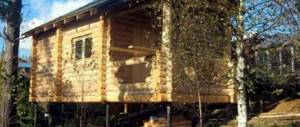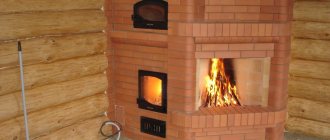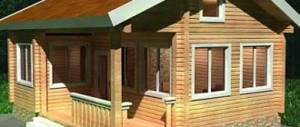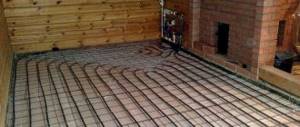The heating stove is rightfully considered the fully functioning heart of the bathhouse.
The main building material for furnace equipment is most often metal or high-strength brick . When laying the foundation for this structure, a significant influence is exerted by the fact that the latter material is much heavier compared to metal, so it requires the construction of a reliable foundation.
When constructing a sauna heating stove, it is recommended to use a special durable material with fire-resistant properties, for example, fireclay bricks. A silicate block will not be suitable in this case, as it is prone to deformation due to exposure to high temperatures.
A sauna stove with a heat exchanger: what is it?
The idea of using as much heat as possible from a stove is not new. A good application is to use it to heat the coolant.
For your information! The principle of any heat exchanger is to ensure maximum contact of an insulated liquid carrier with a heated surface to increase heat transfer between them.
Many designs have been invented to implement this. Let's look at them according to the purpose of the heated liquid.
Electrical
And finally, let’s look at several ways to use electricity to heat a bathhouse. I’ll say right away: take care of the electrics in this case. Since the load on thermal electrical appliances is large, the quality of the electrical wiring should not be in doubt. Consider the total load, wire cross-section, wiring diagram and quality of electrical work.
Firstly, your room can be heated using an electric heater. True, in this case you will have to take care of heating the water in the shower in advance (for example, by installing a direct or indirect heating boiler). This type of heater does not require additional arrangement of the chimney and is considered environmentally friendly.
Secondly, the bathhouse (in particular the relaxation room) can be heated using electric convectors placed on the walls.
Well, thirdly, infrared film can come to your aid - the newest type of heater, which allows you to easily and quickly create warm floors both in the house and in the bathhouse. Detailed technology for installing heated floors is discussed in other articles.
Please note that the installation of heated floors is possible without the use of infrared film, but by laying electric heating cables. They are used both in underfloor heating systems and for heating water pipes.
It is quite possible to use infrared heaters as an additional source of heat. I hung it on the ceiling and forgot about it.
Using electricity to heat a bath undoubtedly has its advantages. You can safely use all the structural elements (heater, heated floor, boiler) at any time all year round. At the same time, you don’t have to worry about fuel or worry about pipes freezing. The only serious drawback can be considered the high energy consumption.
In the case when you do not often use the bathhouse (especially in winter, rarely coming to the dacha), then the most optimal option would be a mixed heating device. For example, a stove is installed and electric heating is installed. If you decide to take a shower, rest or “stretch”, use electricity. If you decide to take a steam bath “like an adult”, turn on the stove thoroughly.
Remember. Whatever the heating in the bathhouse, if you do not use it constantly in winter, then be sure to drain the water from boilers, water heaters, pipes, toilet tank (if there is one), etc. This is guaranteed to protect them from damage, and you from unnecessary headaches.
Heated floor control unit
Application area
Wasted heat can be used for two purposes:
- for heating water to be used for washing;
- for heating rooms.
Of course, such goals can be combined if the stove is powerful enough. After all, we will, in fact, be taking away part of the heat that would otherwise be used to heat the steam room (or atmosphere)).
Scheme of heating water in a remote tank with a samovar-type heat exchanger (video with explanation, see below)
Bath stove with water heat exchanger
This is the first time. We are talking exclusively about water (no antifreeze), the consumption of which depends on the number of people who can wash in the bathhouse at the same time and other factors. In any case, you can’t do without a spacious tank. And here again you have options for where to place it:
- some place the tank directly on the stove , which must have an appropriate design for this. Water is supplied to the washing room from the steam room;
- others use a heat exchanger , and the tank itself is placed in an adjacent room, from where it is connected by two pipes to the heat exchanger.
Both designs of stoves with a tank have a right to exist, and the choice is yours.
Bath stove with heat exchanger for heating
If instead of a tank you connect a heat exchanger with a radiator, you get an autonomous heating system .
Here again you have two options):
- or create a design that is based on phenomena such as convection and gravity;
- or force the coolant to forcefully move in the system - for this you will need a pump, and therefore electricity (! A separate section is devoted to electric stoves).
If the bathhouse is small, then there is no need to bother with even the simplest system, because usually the stove is enough to heat adjacent rooms . But what matters here is what kind of winters you have. It happens that a small bathhouse needs additional heating.
It was already mentioned above that it is possible to combine heating of water for washing and heating. In fact, you can make two parallel systems, and use antifreeze rather than water for heating. For this purpose, one heat exchanger will need to be placed inside the stove, and the second - on the chimney. From the point of view of increasing the efficiency of the furnace, this option is simply excellent.
On a note! When creating a heating system, do not forget about the expansion tank , which will absorb excess coolant.
Bath heating with gas boilers
If gas is supplied to the site, then, naturally, gas heating of the bathhouse is the best option and installing a gas boiler will pay off: they work flawlessly, heat rooms that are quite large in size, and gas does not cost much in our country. There is no soot, soot, or heavy odor. You can do it yourself to heat a sauna using gas, but you must have a project and carefully monitor its implementation. In general, gas heating is an economical and profitable option for the owner, but gas lines in a country house or village are the exception to the rule rather than the rule, so you have to think about how to heat a bathhouse without gas.
Heating a bathhouse in winter. Which method to choose
Types of devices
The furnace provides several options for placing heat exchangers:
A coil or water circuit is a steel structure that can be located both inside the furnace and outside , for example, between the furnace wall and the casing. Its use is not limited to metal stoves - water circuits can also be built into brick ones.
The shape and size can vary significantly from a simple C-shaped, once bent tube with fittings , which is located inside the firebox, to a water jacket around the entire body.
IMPORTANT! The correct location of the metal pipe inside the furnace is always such that the open flame does not touch it in any area. It should be remembered that even stainless steel is subject to oxidation in a flame.
A large tank that touches the walls of the furnace with a wall or bottom (or both) can also be considered a type of heat exchanger.
For your information! By taking heat away from the stove body to heat water, you reduce the operating power of the stove.
But in the design of all furnaces there is an element that in most cases (but not in all!) becomes the cause of significant heat loss - this is the chimney, where very hot furnace gases are sent (if the furnace does not have a smoke circulation system).
The second type of heat exchangers tries to correct this shortcoming. For this purpose, either a small flow-through tank of 5-10 liters , communicating with a large tank outside the steam room, or a full-fledged tank, from where hot water is supplied to the washing room. (In the latter case, there are more difficulties with fastening.)
Photo: samovar-type heat exchanger
Photo: heat exchanger tank on a pipe
By the way! The external tank, among other things, also serves as a heater for the room in which it is installed (dressing room or washing room).
Equipment required for water floor heating in a bathhouse
In addition to the furnace itself, installing a water heated floor involves the purchase and installation of a number of devices and elements.
Table. Equipment for water floor heating in a bathhouse.
| Equipment | Purpose |
| Heat exchanger | To set up the system, you need a container in which water will be heated (from the fuel burned in the stove). A metal tank can be used for this purpose. From it comes the distribution of circuits throughout the rooms. |
| Pump | If the stove is placed at floor level or above it, it will not be possible to create natural circulation of water along the contours. To get the water moving, you need to install a pump. |
| Battery tank | It is unlikely that it will be possible to install a large-volume heat exchanger, so you will need a battery capacity. Otherwise, it will not be possible to completely supply the heated floor with coolant. An additional tank is connected to the system via metal pipes. Heat loss can be eliminated by fixing a thermal insulation layer on the base. |
For water heated floors, additional devices and elements are needed
How it works
It is easy to guess that in the case of a flow-through water circuit or a tank mounted on a chimney, it is necessary to ensure constant circulation of liquid between it and the storage tank outside the steam room.
This can be done either through the natural laws that water obeys (and such a system is considered open), or with the help of a pump that provides forced circulation.
IMPORTANT! Natural circulation based on gravity and convection is preferable. Connecting pipes must have a diameter of at least one inch and a length of no more than 3 meters.
Look at the diagram above, which clearly shows how the pipes should be positioned so that the water rises and falls freely. Below is a video explaining the diagram.
DANGEROUS! Before lighting the stove, make sure there is water in the system!
Video
Watch a short video that explains the above diagram of a stove for a bath with a heat exchanger for water (this principle can also be used for heating) and shows an example of its budget implementation:
Watch the video from our channel: Bath stove with heat exchanger and remote water tank (diagram and example)
Rules for organizing heating in a bathhouse
Wood heating sauna
The simplest option is a sauna with heating from home. This scheme involves connecting the steam room, dressing room and other premises to the autonomous heat supply of the cottage. But this can only be realized if the bathhouse structure is closely adjacent to the house or is located at a distance of no more than 3-4 m from it.
The most common option for the location of a building on a site is remote from a residential building. How to make water heating in a bathhouse and at the same time optimize the costs of its organization? Options for using standard schemes are possible, but at the same time the specifics of using the bathhouse should be taken into account:
- The source of thermal energy (boiler) must ensure heating of the air in the steam room to a level of +90°C +100°C. For this purpose, special sauna stoves with a container for stones are used;
- For rooms larger than 60 m², it is recommended to install pipe heating. Together with it, you can make a hot water system to increase comfort. If there is a second floor, heating of the attic of the bathhouse must be provided;
- Ensuring the removal of carbon monoxide along with a well-thought-out ventilation system;
- Fire safety. Since wood is used in the vast majority of cases for finishing rooms, its contact with heating elements - pipes, radiators - should be prevented.
Gas heating baths
Another important point is the choice of energy carrier. Gas heating in a bathhouse is advisable only when installing a specialized boiler. Installing homemade structures can lead to emergency and dangerous situations.
In addition to gas, you can use other, no less effective sources of thermal energy:
- Firewood. A traditional type of fuel with which heating a bathhouse in winter turns into a kind of ritual. A significant drawback is the constant monitoring of the fuel level in the firebox, as well as the impossibility of quickly adjusting the water heating level;
- Diesel fuel or used oil. The most unacceptable energy source for a bathhouse. The problem is the unpleasant smell and the difficulty in organizing fuel storage.
How to make gas heating for a bathhouse yourself? To do this, you need to choose the right equipment and components for heat supply - pipes, radiators, as well as containers for indirect heating of hot water.
When heating a bathhouse from the heating system of the house, part of the pipeline located on the street must be insulated. To solve this problem, you can use special heat insulators or an electric heating wire.
Popular furnaces with heat exchangers
Cast iron stoves are deservedly popular among lovers of Russian baths, but how are they combined with heat exchangers? As it turns out, they combine perfectly.
Cast iron stove
To get started, we recommend visiting the website of the Petrozavodsk stove manufacturer Karelia. Among the products offered to visitors are components, among which there is a disk-shaped heat exchanger, apparently attached to one of the walls of the furnace. Thus, you can purchase both a stove and an exchanger at once. As an option, they also sell mounted tanks for the chimney.
Cast iron stove with heat exchanger for a bath. Photo source
Vesuvius stove
Vesuvius stove with heat exchanger for a bath
The stove manufacturer Vesuvius also provides the opportunity to simultaneously purchase a stove (and in its catalog you will find both steel and cast iron stoves) and a heat exchanger . The buyer is given a choice of three models - two “samovars” for the chimney, differing in capacity, and one rectangular heat exchanger, which takes heat from the stove wall.
photo of heat exchangers on the Vesuvius website
Stoves for baths "Termofor"
There is a message on the Termofor website that the manufacturer took into account customer preferences and produces the most popular models - Tunguska 16 and Tunguska 24 - with already installed heat exchangers , which require an external location of the storage tank. The material of the exchangers is high-quality food grade stainless steel, 2 mm thick . Depending on the buyer’s choice, the placement can be varied by installing it either on the right or on the left wall of the stove.
Useful video
Termofor sauna stoves with a heat exchanger may be built well, but there are negative reviews. Watch the video and see what it looks like:
Heating system
In most cases, continuous burning stoves are installed in bathhouses. which do an excellent job as the main source of heat in the room. At the same time, it is worth immediately making a reservation that for arranging the stove it is advisable to use only cleaned stones, the diameter of which reaches 10 centimeters. To achieve the optimal temperature in the room, it takes at least two hours to heat such a stove, during which you will have to periodically add firewood.
The bathhouse is a wooden building with a high level of humidity in the premises. As you know, wood that is regularly exposed to water can become unusable in a very short time. Because of this, unpleasant odors may appear in the bathhouse, and the building itself will require repairs in the future.
To avoid this, issues related to its quality heating should be resolved in advance. At the same time, it is advisable not to limit yourself to just one stove, but to supplement it with various heating systems, which, moreover, will significantly reduce the time it takes to warm up the premises before taking water procedures.
For safety reasons, in a wet room such as a bathhouse, it is allowed to use one or two heating radiators, which must be connected to the heating system of a residential building. In addition, there are several other options for heating a bath, the choice of which depends only on your requirements and wishes.
Heating radiators in the bathhouse
DIY making
Despite the availability of different options for sale, you can try your hand at making a heat exchanger yourself. It's not that difficult if you have welding experience. In any case, it’s easier than making a stove from scratch.
But before you get started, you need to do a little calculation.
Calculation of heat exchanger power and area
It was already mentioned above that heat exchangers connected to the body take away part of the furnace power. Therefore, the first rule will be the following:
IMPORTANT! The heat exchanger power should not be more than 1/10 of the furnace power.
The second rule is related to the length of the pipes: if the system is gravity-fed, then you should not extend the pipes further than three meters. The pump in the system eliminates such restrictions. But the pump is installed more often when the coolant is used to heat rooms. However, if the storage tank is not located too high, you can only wash with a hose. If this is inconvenient, then you need to either take the tank into the attic and insulate it, or install the same pump.
The third rule concerns the volume of the heat exchanger (if it is a small flow-through tank and not a coil). The water in it should heat up within a couple of hours. If it’s longer, then the volume is too big. If it is faster, then it is better only at first glance - the water should not boil, this will cause scale, steam, testing the expansion tank, and other problems.
Now, actually, the calculation itself:
The power of the heat exchanger depends on its area: 9 kW for each square meter of exchanger . The area is quite simple to calculate: if it is a coil, then multiply the circumference (3.14 * diameter) by the length of the pipe. If this is a “samovar” heat exchanger, then take the diameter of the inner pipe, multiply it by the number Pi, and multiply it again by the height of the “samovar”.
Power = resulting area in sq. meters * 9 kW.
If the exchanger hangs on the chimney, you can ignore the rule of deducting its power from the power of the stove. Only if he is on or in her body.
You can calculate the power required to heat a room using the same principle as for a steam room, that is, based on the volume of the room. In the steam room, a kilowatt per cubic meter is taken, but the adjacent ones do not need high temperature, so focus on half the value.
Knowing how many kilowatts are needed to heat a washing room, you get the area of the heat exchanger, and from it the length of the pipe for the “samovar” or coil.
Let's consider a couple of options for self-manufacturing heat exchangers.
Let's assume that you decide to increase the efficiency of the stove by installing a heat exchanger on the chimney.
- The thickness of the steel required for this is 2.5 mm.
- In addition to the sheet material, you will need two pipes with different diameters.
- The smaller one should be adjacent to the chimney pipe, the larger one should be 5-10 cm wider than the first one.
- Two circles are cut out of sheet metal to fit the diameter of the larger pipe, then a hole is cut in the center to fit the diameter of the smaller one and everything is carefully welded.
- You also need to make holes for the pipes through which water will come and go.
- The pipes are threaded and must match the diameter of the connecting pipes.
ADVICE! After checking the tightness of the seams, installation on the chimney and routing of pipes, it is recommended to insulate the heat exchanger using mineral wool and foil - this will dramatically increase the rate of water heating.
Another option for a heat exchanger for a chimney is a coil made of a copper tube with a diameter of 10 mm, which is made to tightly wrap around the chimney pipe. 1.5-2 meters of pipe is enough. The ends of the coil are inserted into the nuts, flared under the fittings, and then the fittings are screwed to the nuts.
Note! The copper tube must be flared exactly under the cone of the fitting so that they eventually fit tightly against each other. Be careful because this is where leaks can occur in the future if you flare at an uneven thickness.
Here are a couple of videos on the topic:
Video
How to bend a copper tube yourself with a pipe bender.
Without pipe bender.
For home
When choosing a furnace with a water circuit for your home, you should keep in mind that here it works constantly.
Here are the conclusions drawn from this:
- A heat exchanger on the chimney is not a suitable option, since in case of constant use it leads to rapid clogging of the pipe (due to abundant condensation).
- If the house has a conventional heating system consisting of radiators and designed for a coolant with a high temperature (up to 95 degrees), then a heat exchanger of the “boiler” or “pipes inside the firebox” type can be considered suitable.
If a low-temperature heating system is installed (underfloor heating, heated baseboards or large copper/aluminum radiators), preference should be given to pipe registers along the stove body, or to a coil installed in the firebox, in which the heating intensity can be adjusted by changing the amount of flue gases washing it.
Principles of installation, connection and safe operation
- Installation options depend only on the choice of location of the exchanger. The most difficult thing will happen if you decide to place it inside a finished oven , where it was not originally planned. For this you will have to disassemble the case and make holes. It is much easier to use a hanging structure or put a coil or a “samovar” on the chimney pipe.
- As for the pipes that connect the heat exchanger to the tank, for a gravity-flow design it is important to observe slopes, and also remember that the fastening of the pipes should not be rigid - allow them to “walk” freely during thermal expansion.
- The material for pipes is best copper , and connections are brass . When purchasing seals, pay attention to their ability to withstand high temperatures.
Operating safety depends on your awareness. The main thing is not to forget about two things:
- when leaving the bathhouse, you need to drain all the water from the system;
- You should not start heating without making sure that the storage tank is full of water.
If a brick oven with an internal water circuit is flooded and you forgot to add water in time, it is better not to do this when the oven is heated.
It is also important to prevent the liquid from boiling in the system.
We combine the heating of the dacha with the heating of the bathhouse
Twenty or thirty years ago, it never occurred to anyone that it was possible to create heating for a bathhouse from home. It was always believed: a bathhouse, there is a bathhouse, a house, there is a house, and they will not be connected together. However, modern technologies, the desire of owners to save money, and some other needs make it possible to think about how to install heating from a house to a bathhouse.
Any boiler requires a separate room, which must comply with all safety regulations and standards. In fact, without creating and approving a project in the relevant authorities, nothing will happen. All this requires both time and significant financial costs.
We connect the house and the bathhouse with a heating main
A heating main laid by yourself will be cheaper. Many amateur bath attendants do this. But even in this situation, there are certain rules and small tricks, knowing which a non-professional will avoid many problems in the future:
- When designing a heating main, take into account the location of groundwater: pipes should not be in water.
- The pipeline must be insulated, and a larger diameter pipe is put on top (corrugation can be used). Then it will be protected from groundwater, and heat loss will be small.
In general, the efficiency of such a bathhouse heating system will depend on the distance at which the bathhouse is located from the house. If the distance is short, then this option may be the best. But if the distance is significant, then it may turn out that by the time the water reaches the bathhouse, it will have cooled down so much that it will not be able to somehow influence its temperature.
Sauna stoves with a heat exchanger: reviews
Reviews from consumers whose washrooms receive hot water from a heat exchanger in a steam room or whose bathhouses are heated with its help are usually positive.
According to one of the users, he kept a boiler in the bathhouse for some time to heat water, but for the sake of saving money he decided to switch to a cheaper design. And after thinking a little more, I didn’t buy a ready-made one at all, but twisted the coil myself and installed it inside the oven. I'm pleased with the result.
Also, those who purchased a stove with a built-in water circuit do not complain, because the water becomes hot in an hour and a half, and the steam room arrives in two.
There are no problems with the heating systems either - the radiators installed in the cold dressing room by another bathhouse owner solved the problem of cold, the stove copes well with heating the combined washing room and steam room, and with heating the dressing room.
***
Are you convinced that a sauna stove with a heat exchanger is better and more profitable than a boiler? It will heat the adjacent rooms and provide hot water for washing. And at the same time, the efficiency of the stove will increase if you hang the exchanger on the chimney pipe. Exchangers are inexpensive, but it’s easy to make them yourself. In general, we recommend an affordable solution.
Why do you need a heat exchanger?
The vast majority of sauna stove designs do not contribute to saving wood fuel. This is due to the specific requirements for them, namely:
- the steam room should be heated in the shortest possible time to a high temperature;
- the stove cannot take up much space;
- the presence of a heater is mandatory;
- The heater operating mode is periodic.
Based on the listed requirements, sauna stoves are designed in such a way as to quickly reach a high temperature in the firebox and maintain it for a certain period of time. In this case, a lot of unused heat simply escapes into the atmosphere through the chimney. It would be a sin not to use this thermal energy to heat water for washing or even heating the rooms adjacent to the steam room.
Note. An exception is Kuznetsov's brick bell-type stoves intended for baths. A well-thought-out design allows you to significantly save firewood, the stove retains heat for a long time and also heats neighboring rooms. There are also modifications using a water heat exchanger.
One of the simplest solutions is to use the heat generated by burning wood. Currently, there are many models of stoves with a built-in coil on the market. If a heater without a water circuit is already installed and functioning, nothing prevents it from being equipped with a homemade or factory-made heat exchanger. Then you won’t have to spend money on a boiler and then pay for electricity.
Heating diagrams for a bathhouse complex
Choosing a heat supply scheme is a top priority. Thanks to the development of technology, you can choose combined stoves for heating and saunas, or models with heaters. It all depends on the size of the room - its area, volume, number of floors and number of rooms.
Heat supply for a bath without pipelines and radiators
Traditional bath heating scheme
The first task of organizing heat supply for a bathhouse is to choose a heating scheme and ensure the required temperature level in the steam room. For small rooms, you can do without heating, since the heat from the surface of the stove will be enough to heat the entire room.
When heating a bathhouse with your own hands using this scheme, you need to think about the location of the boiler and choose the right model. Its main task is to maintain the optimal heating level in the steam room. To do this, you can use an electric boiler to heat the bathhouse or its gas equivalent. The main thing is that the design includes the following components:
- Fuel combustion zone (gas models) or heating element (electric boiler);
- A heat exchange device through which heat is transferred from the fuel to the air in the room and the stone container;
- Kamenka. Necessary for energy storage and steam formation.
Sauna stove lining
Such heating of a country bath has one condition - large heat transfer from the entire surface of the boiler. This is due to the need to warm up at least two rooms - the steam room and the dressing room. Therefore, often in the photo of heating installation in a bathhouse you can see that the steel body of the boiler is lined with fireclay bricks or ceramic plates.
This technology allows you to solve two problems - protection from harsh thermal radiation and uniform heating of the air in the room even after the boiler has stopped. Brick, natural stone and ceramic plates are good heat accumulators.
To organize hot water supply, you can install a special tank containing water on the chimney pipe. This will allow you to have a full-fledged shower in the bathhouse.
Bath heating schemes
Water heating and hot water baths
Installing full gas heating in a bathhouse is the best option for rooms with medium and large areas. However, difficulties may arise when drawing up a diagram and selecting heating components.
First of all, you need to solve the question of how to make water heating for your bathhouse yourself. The use of standard schemes is not always advisable, since they are designed for residential buildings. It is necessary to take into account the specifics of the operation of the bathhouse:
- To operate the heat supply, you will need a combined stove for heating and sauna. Structurally, it is distinguished by the presence of a heat exchanger connected to pipelines.
- Location and design power of radiators. For a Russian bath, the temperature regime should be from +65°C to +75°C. In a Finnish sauna this figure can reach +110°C. In the waiting room, the air heating level should be at least +25°C. In other rooms, the temperature should not be lower than the established norm of +22°C. Based on this, the optimal power of the radiators is calculated.
- Selection of components. When heating a bathhouse with your own hands, increased humidity and temperature should not affect the condition of pipes and radiators. Therefore, it is recommended to select models in which the rusting process is impossible or proceeds very slowly. These include cast iron batteries and bimetallic radiators.
Proper gas heating of a bathhouse can be done in two ways - by connecting to a natural gas pipeline or using its liquefied analogue. In the first case, it is necessary to obtain permits. The installation of heating equipment is carried out by representatives of a management company or a specialized organization licensed for this type of work.
Gas heating baths
If the country bath is heated using bottled or liquefied gas, the following conditions must be met:
- Organizing a place to store cylinders or installing a special container - a gas holder. It is strictly forbidden to store gas containers in a living room or boiler room. In the case of a bathhouse, this is the room in which the boiler is located;
- A line for sorting gas from the storage location to the boiler burner. It is made of special pipes designed for a certain pressure and with a minimum probability of gas leakage;
- Taking into account the increased power of the boiler, it is necessary to consider installing an appropriate chimney system to remove carbon monoxide. Analyzing the photo of heating installation for a bathhouse, you can see that sandwich systems are most often used. They are characterized by a minimal amount of moisture on the inner surface of the pipe, which practically does not affect the operation of the boiler.
To heat baths in winter, a hot water supply system must be provided. It can be done using an indirect heating tank connected to the heating supply. Since the intensity of water use will be low, you can limit yourself to models with a capacity of up to 200 liters.
When installing an electric boiler with a heater, it is recommended to install independent heating. To do this, you can use a small solid fuel stove or modern models of electric boilers - ion or induction.










